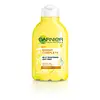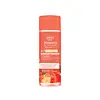What's inside
What's inside
 Key Ingredients
Key Ingredients

 Benefits
Benefits

 Concerns
Concerns

 Ingredients Side-by-side
Ingredients Side-by-side

Water
Skin ConditioningAlcohol Denat.
AntimicrobialGlycerin
HumectantButylene Glycol
HumectantDimethicone
EmollientCyclopentasiloxane
EmollientAscorbyl Glucoside
AntioxidantCapryloyl Salicylic Acid
ExfoliatingCitrus Limon Fruit Extract
MaskingGentiana Lutea Extract
EmollientTocopheryl Acetate
AntioxidantAcrylates/C10-30 Alkyl Acrylate Crosspolymer
Emulsion StabilisingAmmonium Polyacryloyldimethyl Taurate
Emulsion StabilisingSodium Polyacryloyldimethyl Taurate
Emulsion StabilisingDisodium EDTA
T-Butyl Alcohol
PerfumingTriethanolamine
BufferingXanthan Gum
EmulsifyingMethylparaben
PreservativePhenoxyethanol
PreservativeParfum
MaskingBenzyl Salicylate
PerfumingGeraniol
PerfumingLimonene
PerfumingLinalool
PerfumingWater, Alcohol Denat., Glycerin, Butylene Glycol, Dimethicone, Cyclopentasiloxane, Ascorbyl Glucoside, Capryloyl Salicylic Acid, Citrus Limon Fruit Extract, Gentiana Lutea Extract, Tocopheryl Acetate, Acrylates/C10-30 Alkyl Acrylate Crosspolymer, Ammonium Polyacryloyldimethyl Taurate, Sodium Polyacryloyldimethyl Taurate, Disodium EDTA, T-Butyl Alcohol, Triethanolamine, Xanthan Gum, Methylparaben, Phenoxyethanol, Parfum, Benzyl Salicylate, Geraniol, Limonene, Linalool
Water
Skin ConditioningGlycerin
HumectantPropylene Glycol
HumectantHyaluronic Acid
HumectantMethyl Gluceth-20
HumectantPEG-60 Hydrogenated Castor Oil
EmulsifyingSolanum Lycopersicum Meristem Cell
AntioxidantLactobacillus/Tomato Fruit Ferment Extract
Skin ConditioningPhenoxyethanol
PreservativeNiacinamide
SmoothingXanthan Gum
EmulsifyingBetaine
HumectantParfum
MaskingCitric Acid
BufferingTrehalose
HumectantAllantoin
Skin ConditioningPanthenol
Skin ConditioningDisodium EDTA
Arbutin
AntioxidantTocopheryl Acetate
AntioxidantSorbic Acid
PreservativeHydrolyzed Hyaluronic Acid
HumectantAscorbyl Glucoside
AntioxidantWater, Glycerin, Propylene Glycol, Hyaluronic Acid, Methyl Gluceth-20, PEG-60 Hydrogenated Castor Oil, Solanum Lycopersicum Meristem Cell, Lactobacillus/Tomato Fruit Ferment Extract, Phenoxyethanol, Niacinamide, Xanthan Gum, Betaine, Parfum, Citric Acid, Trehalose, Allantoin, Panthenol, Disodium EDTA, Arbutin, Tocopheryl Acetate, Sorbic Acid, Hydrolyzed Hyaluronic Acid, Ascorbyl Glucoside
 Reviews
Reviews

Ingredients Explained
These ingredients are found in both products.
Ingredients higher up in an ingredient list are typically present in a larger amount.
Ascorbyl Glucoside is a stable form of Vitamin C. It is created by combining glucose from starch.
When applied to skin, Ascorbyl Glucoside turns into Ascorbic Acid.
Ascorbyl Glucoside is an antioxidant. Antioxidants help fight free-radicals, or molecules that may damage skin cells.
It can help to reduce redness, improve skin texture, reduce the effects of aging, reduce the visibility of dark spots, and brighten skin.
Read more about other types of Vitamin C:
Learn more about Ascorbyl GlucosideDisodium EDTA plays a role in making products more stable by aiding other preservatives.
It is a chelating agent, meaning it neutralizes metal ions that may be found in a product.
Disodium EDTA is a salt of edetic acid and is found to be safe in cosmetic ingredients.
Learn more about Disodium EDTAGlycerin is already naturally found in your skin. It helps moisturize and protect your skin.
A study from 2016 found glycerin to be more effective as a humectant than AHAs and hyaluronic acid.
As a humectant, it helps the skin stay hydrated by pulling moisture to your skin. The low molecular weight of glycerin allows it to pull moisture into the deeper layers of your skin.
Hydrated skin improves your skin barrier; Your skin barrier helps protect against irritants and bacteria.
Glycerin has also been found to have antimicrobial and antiviral properties. Due to these properties, glycerin is often used in wound and burn treatments.
In cosmetics, glycerin is usually derived from plants such as soybean or palm. However, it can also be sourced from animals, such as tallow or animal fat.
This ingredient is organic, colorless, odorless, and non-toxic.
Glycerin is the name for this ingredient in American English. British English uses Glycerol/Glycerine.
Learn more about GlycerinParfum is a catch-all term for an ingredient or more that is used to give a scent to products.
Also called "fragrance", this ingredient can be a blend of hundreds of chemicals or plant oils. This means every product with "fragrance" or "parfum" in the ingredients list is a different mixture.
For instance, Habanolide is a proprietary trade name for a specific aroma chemical. When used as a fragrance ingredient in cosmetics, most aroma chemicals fall under the broad labeling category of “FRAGRANCE” or “PARFUM” according to EU and US regulations.
The term 'parfum' or 'fragrance' is not regulated in many countries. In many cases, it is up to the brand to define this term.
For instance, many brands choose to label themselves as "fragrance-free" because they are not using synthetic fragrances. However, their products may still contain ingredients such as essential oils that are considered a fragrance by INCI standards.
One example is Calendula flower extract. Calendula is an essential oil that still imparts a scent or 'fragrance'.
Depending on the blend, the ingredients in the mixture can cause allergies and sensitivities on the skin. Some ingredients that are known EU allergens include linalool and citronellol.
Parfum can also be used to mask or cover an unpleasant scent.
The bottom line is: not all fragrances/parfum/ingredients are created equally. If you are worried about fragrances, we recommend taking a closer look at an ingredient. And of course, we always recommend speaking with a professional.
Learn more about ParfumPhenoxyethanol is a preservative that has germicide, antimicrobial, and aromatic properties. Studies show that phenoxyethanol can prevent microbial growth. By itself, it has a scent that is similar to that of a rose.
It's often used in formulations along with Caprylyl Glycol to preserve the shelf life of products.
Tocopheryl Acetate is AKA Vitamin E. It is an antioxidant and protects your skin from free radicals. Free radicals damage the skin by breaking down collagen.
One study found using Tocopheryl Acetate with Vitamin C decreased the number of sunburned cells.
Tocopheryl Acetate is commonly found in both skincare and dietary supplements.
Learn more about Tocopheryl AcetateWater. It's the most common cosmetic ingredient of all. You'll usually see it at the top of ingredient lists, meaning that it makes up the largest part of the product.
So why is it so popular? Water most often acts as a solvent - this means that it helps dissolve other ingredients into the formulation.
You'll also recognize water as that liquid we all need to stay alive. If you see this, drink a glass of water. Stay hydrated!
Learn more about WaterXanthan gum is used as a stabilizer and thickener within cosmetic products. It helps give products a sticky, thick feeling - preventing them from being too runny.
On the technical side of things, xanthan gum is a polysaccharide - a combination consisting of multiple sugar molecules bonded together.
Xanthan gum is a pretty common and great ingredient. It is a natural, non-toxic, non-irritating ingredient that is also commonly used in food products.
Learn more about Xanthan Gum